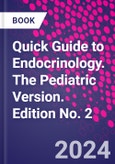Quick Guide to Endocrinology, The Pediatric Version, Second Edition, continues to be an essential resource which focuses on the physiology, diagnostics, and laboratory testing of endocrine (hormone-mediated) disorders encountered in the field of endocrinology with expanded coverage of pediatric endocrinology. The guide is for laboratory scientists and technicians, as well as trainees and clinicians in the field of pediatrics and pediatric endocrinology including fellows, residents, medical students, nursing students, and advance practice providers and students. It is presented in an easy to read, quick format, the physiology and method of measurement for hormones essential to many bodily processes and how their dysregulation results in disease. The characteristics of such diseases and diagnostic testing including up-to-date molecular testing is addressed.
Please Note: This is an On Demand product, delivery may take up to 11 working days after payment has been received.
Table of Contents
1. Introduction2. Definition and Description of Hormones
3. Hormone Secretion and Transport
4. Hormone Actions
5. Hormone Regulation
6. Manifestations of Endocrine Disorders
7. Hormone and molecular assays
8. Pituitary
9. Anterior Pituitary
10. Physiology
11. FSH, LH, ACTH, TSH
12. Prolactin
13. Growth Hormone
14. Posterior Pituitary
15. Physiology 16. ADH17. Oxytocin
18. When to get molecular testing
19. Thyroid Gland
20. Physiology
21. Thyroid hormone
22. Measurements/Interferences
23. Effects of Coexistent Disorders, Iodine Deficiency/Excess, Drugs, and Toxins on Thyroid Function
24. Thyroid disorders
25. Molecular Testing
26. Thyroid disease in pregnancy
27. Sick euthyroid syndrome
28. Thyroid cancer
29. Newborn Screening the General Population for Thyroid Dysfunction
30. Adrenal Gland
31. Physiology
32. Measurements/Interferences
33. Adrenocortical diseases
34. Newborn Screening for CAH and ADL
35. Adrenomedullary Diseases
36. When to get molecular testing
37. Reproductive Endocrinology
38. Normal Physiology (pregnancy)
39. Measurements/Interferences
40. Hypogonadism
41. Pubertal Disorders
42. Disorders Related to Calcium
43. Physiology
44. Measurements/Interferences
45. Hypercalcemia








